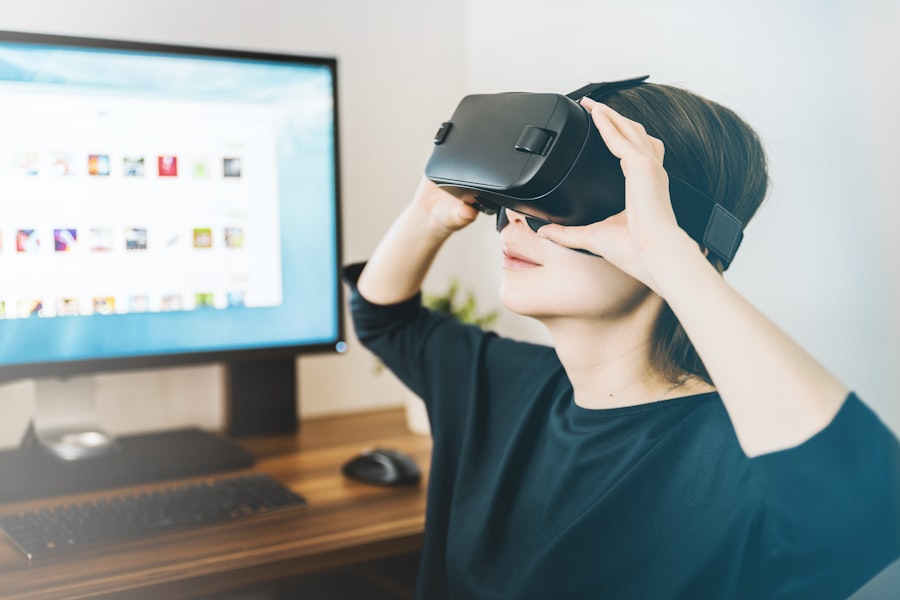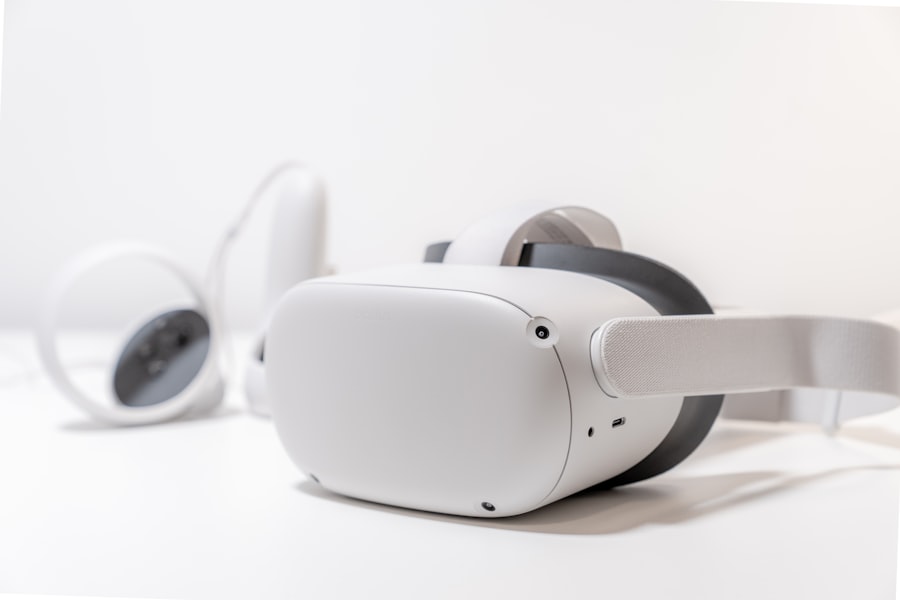Download links
How to install Exploring the Virtual Life: A New Frontier APK?
1. Tap the downloaded Exploring the Virtual Life: A New Frontier APK file.
2. Touch install.
3. Follow the steps on the screen.
Description
The concept of virtual reality (VR) has evolved dramatically since its inception, transitioning from a niche technological curiosity to a mainstream phenomenon that permeates various aspects of daily life. Initially, VR was confined to the realms of science fiction and specialized applications, such as flight simulators and military training. However, with advancements in technology, particularly in graphics processing, motion tracking, and user interface design, VR has become more accessible and immersive.
The introduction of affordable headsets like the Oculus Rift, HTC Vive, and PlayStation VR has democratized access to virtual experiences, allowing a broader audience to engage with this innovative medium. As VR technology continues to advance, it is reshaping how individuals interact with digital content and each other. The allure of stepping into a fully realized 3D environment offers users an escape from the constraints of the physical world.
This immersive experience can transport users to fantastical realms, historical settings, or even simulated environments that replicate real-world scenarios. The rise of social VR platforms, such as VRChat and Rec Room, has further enhanced this experience by enabling users to connect with others in shared virtual spaces. As a result, the virtual life is not merely a technological advancement; it represents a cultural shift in how we perceive reality and our interactions within it.
Key Takeaways
- Virtual reality has seen a significant rise in popularity, offering users a new way to experience life through technology.
- Getting started in virtual worlds requires navigating through various platforms and understanding the tools and equipment needed for a seamless experience.
- The impact of virtual reality on society brings both benefits, such as enhanced education and entertainment, and drawbacks, including potential addiction and social isolation.
- Virtual relationships in virtual worlds have unique dynamics, allowing users to interact and form connections in ways that differ from traditional social interactions.
- The virtual economy is on the rise, with the buying and selling of virtual goods and services becoming a significant aspect of the virtual reality industry.
- The future of the virtual life holds endless possibilities, with predictions of continued growth and advancements in the virtual reality industry.
Navigating Virtual Worlds: How to Get Started in the Virtual Life
Embarking on a journey into virtual reality requires more than just acquiring the necessary hardware; it involves understanding the various platforms and experiences available.
Options range from high-end devices like the Valve Index, which offers superior tracking and visual fidelity, to standalone headsets like the Meta Quest 2, which provides a more accessible entry point without the need for a powerful gaming PEach headset comes with its own ecosystem of games and applications, making it essential for users to research which platform best suits their preferences.
Once equipped with a headset, users can explore a plethora of virtual worlds designed for various purposes. Gaming remains one of the most popular applications of VR, with titles like “Beat Saber” and “Half-Life: Alyx” showcasing the medium’s potential for interactive storytelling and gameplay. However, VR is not limited to gaming; educational applications are gaining traction as well.
Platforms like Engage and AltspaceVR offer immersive learning experiences that allow users to attend lectures or participate in workshops in virtual classrooms. For those interested in socializing, platforms such as VRChat provide an expansive universe where users can create avatars, interact with others, and participate in community events. Navigating these diverse offerings can be overwhelming at first, but as users become familiar with their chosen platforms, they can tailor their virtual experiences to suit their interests.
The Impact of Virtual Reality on Society: Exploring the Benefits and Drawbacks

The integration of virtual reality into society has sparked significant debate regarding its benefits and drawbacks. On one hand, VR has the potential to revolutionize various fields such as education, healthcare, and entertainment. In education, for instance, VR can create immersive learning environments that enhance student engagement and retention.
Medical students can practice surgical procedures in a risk-free setting, while history students can explore ancient civilizations through virtual field trips. These applications demonstrate how VR can facilitate experiential learning that traditional methods may struggle to achieve. Conversely, the rise of virtual reality also raises concerns about its impact on mental health and social behavior.
Critics argue that excessive immersion in virtual worlds can lead to social isolation and detachment from reality. The phenomenon of “VR addiction” has emerged as individuals may prioritize their virtual lives over real-world relationships and responsibilities. Furthermore, issues related to privacy and data security are increasingly relevant as users navigate these digital spaces.
The collection of personal data by VR platforms poses risks that could lead to misuse or exploitation. As society continues to embrace virtual reality, it is crucial to strike a balance between harnessing its benefits while addressing the potential negative consequences.
Virtual Relationships: Understanding the Dynamics of Social Interactions in Virtual Worlds
| Metrics | Data |
|---|---|
| Number of Virtual Worlds | 10 |
| Participants | 500 |
| Duration of Study | 6 months |
| Types of Social Interactions | Chat, Emotes, Group Activities |
| Relationship Dynamics | Friendship, Collaboration, Conflict |
In virtual environments, social interactions take on new dimensions that differ significantly from those in the physical world. Users create avatars that represent them in these digital spaces, allowing for a degree of anonymity and self-expression that can alter how individuals engage with one another. This anonymity can foster openness and creativity; users may feel more comfortable expressing themselves without the constraints of their physical appearance or societal expectations.
For instance, someone who may be shy or introverted in real life might find it easier to connect with others in a virtual setting where they can adopt a different persona. However, the dynamics of virtual relationships also present unique challenges. The lack of physical presence can lead to misunderstandings or miscommunications that might not occur in face-to-face interactions.
Additionally, the transient nature of many virtual interactions—where friendships can be formed and dissolved quickly—can lead to feelings of loneliness or superficiality. As individuals navigate these complex social landscapes, understanding the nuances of virtual relationships becomes essential for fostering meaningful connections.
Virtual Economy: The Rise of Virtual Goods and Services
The emergence of virtual reality has given rise to an expansive virtual economy characterized by the buying and selling of digital goods and services. This economy encompasses everything from virtual real estate in platforms like Decentraland to custom avatar accessories in games like Fortnite. Users are increasingly willing to invest real money into these digital assets, driven by the desire for personalization and status within virtual communities.
The concept of ownership in virtual spaces is evolving; items that exist solely in digital form can hold significant value, leading to new business models centered around virtual goods. Moreover, the rise of non-fungible tokens (NFTs) has further transformed the landscape of virtual commerce. NFTs allow creators to tokenize their digital art or assets, providing proof of ownership and authenticity that can be bought or sold on various marketplaces.
This innovation has opened up new revenue streams for artists and developers while also raising questions about copyright and intellectual property rights in the digital realm. As the virtual economy continues to grow, it is essential for participants to navigate this landscape with an understanding of its complexities and implications.
The Future of the Virtual Life: Predictions and Possibilities for the Virtual Reality Industry

Looking ahead, the future of virtual reality holds immense potential for innovation and expansion across multiple sectors. As technology continues to advance, we can expect improvements in hardware capabilities that will enhance user experiences significantly. Developments such as haptic feedback suits could provide users with tactile sensations that mimic real-world interactions, further blurring the lines between physical and virtual realities.
Additionally, advancements in artificial intelligence may lead to more sophisticated non-player characters (NPCs) that can interact with users in more meaningful ways. The integration of augmented reality (AR) with VR is another area ripe for exploration. As companies like Apple invest heavily in AR technology, we may see hybrid experiences that combine elements of both realities, allowing users to interact with digital content superimposed onto their physical surroundings.
This convergence could revolutionize industries such as retail, where customers might try on clothes virtually before making a purchase or experience immersive advertising campaigns that engage them on multiple levels. As we venture further into this uncharted territory, ethical considerations will also play a crucial role in shaping the future of virtual life. Issues surrounding data privacy, mental health impacts, and equitable access to technology will need to be addressed as society navigates this new frontier.
The potential for VR to enhance human experiences is vast; however, it is imperative that stakeholders—developers, policymakers, and users alike—collaborate to ensure that this technology serves as a force for good in society rather than a source of division or harm.
If you’re interested in exploring the virtual world of gaming, you may want to check out an article on the advantages of Free Fire Max for fishing experiences. This article discusses how Free Fire Max enhances the fishing experience for players, providing a more immersive and realistic virtual fishing experience. You can read more about it here.
FAQs
What is virtual life?
Virtual life refers to the experience of living and interacting in a digital or virtual environment, often through the use of technology such as virtual reality, augmented reality, or online platforms.
What are some examples of virtual life?
Examples of virtual life include virtual reality games, social media platforms, online communities, and virtual worlds where users can create avatars and interact with others in a simulated environment.
How does virtual life differ from real life?
Virtual life differs from real life in that it takes place in a digital or simulated environment, often with different rules and dynamics than those of the physical world. Users can have different identities, experiences, and interactions in virtual life compared to real life.
What are the benefits of virtual life?
Some benefits of virtual life include the ability to connect with others from around the world, explore new experiences and environments, and engage in activities that may not be possible in real life. Virtual life can also provide a sense of escapism and entertainment.
What are the potential drawbacks of virtual life?
Potential drawbacks of virtual life include the risk of addiction, social isolation, and the blurring of boundaries between virtual and real life. There may also be concerns about privacy, security, and the impact of prolonged exposure to virtual environments on mental and emotional well-being.
How is virtual life evolving with technology?
Virtual life is evolving with advancements in technology, such as the development of more immersive virtual reality experiences, the integration of artificial intelligence in virtual environments, and the use of virtual spaces for education, training, and therapy.





